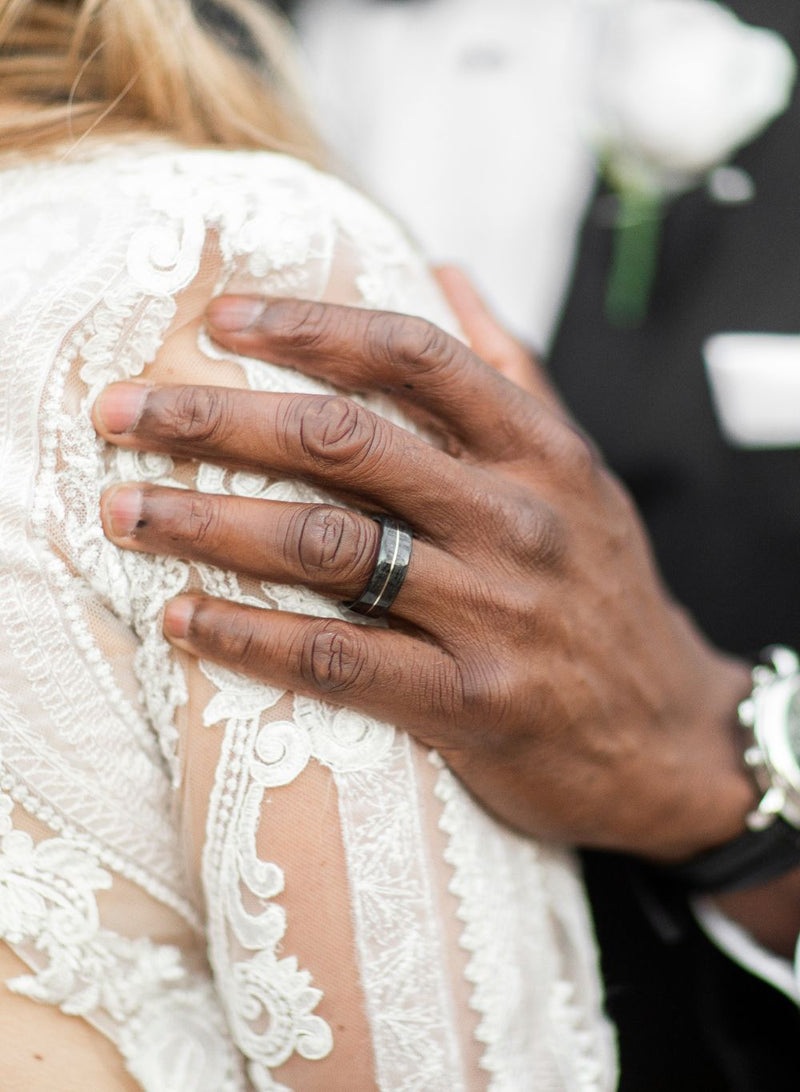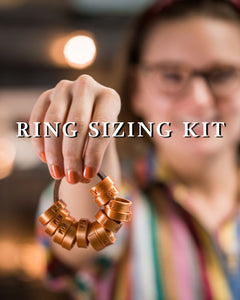What Does a Wedding Ring Symbolize?
July 02 2020 – Mike Yarbrough

The wedding ring is a timeless emblem of love and commitment. Rings have symbolized many things throughout history, carrying meanings both personal and spiritual. Perhaps their most important meanings are known only to those who wear them.
Today's bride and groom have more wedding ring options than ever before. You can choose among countless wedding ring styles and materials to tell your story and express your love. Still, the symbolism of a wedding ring remains much the same as it has for countless generations. In many ways, the love we experience today is no different from that of our ancient ancestors.
What Does a Wedding Ring Symbolize?
The symbolism of a wedding ring is closely tied in with the symbolism of its shape—a circle. Throughout history, circles have been used as a metaphor for concepts of totality, wholeness, perfection, the self, infinity, eternity, and timelessness.
Circles have also been seen as symbols for God, both in Christian faiths as well as many other religions. Circles have no beginning and no end, and their symmetry has made them symbols for heaven and God's perfection.
The eternal nature of a circle has also made rings—especially wedding rings—symbols not only of love, but eternal love. By giving an engagement ring or exchanging wedding bands, you are promising that you will love and remain devoted to one another throughout all of time.
Wedding Rings Throughout History
Wedding rings have a long and complicated history stretching back thousands of years. Though giving a ring as a sign of love and fidelity is an ancient tradition, it has changed and been reshaped many times over the centuries. Ancient Egyptians were among the first to give wedding rings, around 6,000 years ago. The tradition was picked up by ancient Greek and Roman cultures, and has waxed and waned in European countries ever since.
Ring styles and materials have changed a lot too. Wedding rings were most often made of leather, ivory or bone in ancient Rome. Even as metal rings began to become more popular, they were typically made of inexpensive metals like iron. Silver and gold rings would be worn only by the very wealthy.
Elsewhere in Europe, wedding ring styles went through a variety of trends. It's interesting to take a long view of history and see emerging fads that would come and go, just like today. Some old-fashioned types of wedding rings exist now only in museums, while others have left a more lasting influence:
- Gimmel rings were commonly given by husbands to wives during the 16th and 17th centuries. Designed with two interlocking bands that could be separated and then put together like puzzle pieces, gimmel rings would sometimes be separated during the engagement. The man and woman would each wear half of the ring and then reunite the two pieces at the wedding, to be worn by the wife thereafter.
-
Poesy rings gained popularity during the Renaissance. They get their name from the inscription of a poem, or "poesy," which was usually inside the band. Typically made of simple sterling silver, poesy rings were much like today's promise rings, given as a token of love, friendship, or commitment.
- Fede rings have a design in which the band is made with two clasping hands, which usually represent betrothal. Especially popular in the 12th century, fede rings are similar to Irish Claddagh rings, which are still worn to this day. Claddagh rings include two hands holding a heart with a crown.
Types of Rings
Modern rings are more unique and diverse than ever. You can find rings in almost any imaginable style, made from an incredible range of materials. While plenty of couples choose a classic diamond engagement ring, and wedding rings made of traditional gold or silver, the options certainly don't end there.
What ring material best tells your story? It could be whiskey barrel wood, naturally shed elk antler, Celtic tartan wool, or even handcrafted leather. It could include various types of wood, along with inlays of precious metals or other meaningful materials.
But perhaps more important than the material your ring is made of, is the ring's purpose. If you're buying a ring to give to a significant other, consider the meaning behind it. Consider what you want the ring to say. While the options are endless, there are a few basic categories that most rings fall into:
-
Wedding rings represent the unbreakable bond of lifelong love and commitment between two married people. They are exchanged as part of the marriage ceremony in the United States and many other countries, and are often—but not always—made with a relatively simple design. Wedding rings are sometimes referred to as wedding bands, and are worn by both men and women.
-
Engagement rings are, in most cases, given from one partner to another as part of a marriage proposal. Traditionally, an engagement ring is given by the groom-to-be to the bride-to-be, but there's no rule that says men can't also wear engagement rings. They often include at least one precious stone in the design.
-
Promise rings are often thought of as sort of a pre-engagement ring, as a promise to become engaged at a future time. But promise rings can also be given as a token of any promise. They may represent a promise of sobriety, a promise of continued friendship, or any other pact or commitment between two people.
- Statement rings do just what their name implies—make a statement. Many people wear them simply because they like the way they look, while others wear a statement ring that holds some deeper significance, or represents a closely-held value or memory. A statement ring can have any design you can think of, but most have a bold, eye-catching look.
Wedding Ring Traditions
Considering how long wedding rings have been a central part of our culture, the modern wedding ring exchange as we know it is a fairly recent tradition. Throughout most of recorded history, it was only the bride who wore a ring. There was also a time when wedding rings were seen as almost a mark of ownership, rather than a symbol of committed partnership like they are today. Thankfully, times have changed.
The exact origins of the now-common wedding ring exchange are not completely clear, but some of the earliest records of rings being exchanged by the bride and groom come from the Netherlands in the early 1800s. It was not until the 20th century that the practice became commonplace in the U.S.
The differentiation between engagement rings and wedding bands is also a relatively modern notion (one that was, in part, encouraged by the diamond industry in the 20th century). These days, more and more couples are choosing rings that double as both engagement and wedding rings, focusing more on the ring's meaning and story rather than just looking for a shiny rock. It's also not uncommon for couples to purchase matching wedding band sets.
How to Wear a Wedding Ring
Traditionally, weddings are worn on the fourth finger (i.e. the ring finger) of the left hand. This is a tradition that dates back almost as far as the wedding ring itself. It was the ancient Egyptians who believed that this particular finger contained a special vein that connected directly to the human heart. They called it vena amoris, or the "vein of love."
Questionable ideas about human anatomy aside, the Egyptians began a tradition that has stayed with us to this day. That being said, there are, and have always been, alternative ways of wearing a wedding ring. In many cultures it is customary to wear the ring on the right hand, but in the U.S. it is almost universal for the bride and groom to place wedding rings on the ring finger of the left hand during the wedding ceremony.
Most spouses choose to continue wearing their wedding bands throughout their lives as a symbol of their unending love and commitment. Many never take their rings off. Others, especially those who have jobs that might make wearing a ring dangerous (electricians, mechanics, police officers), may choose to wear their rings on a chain around their necks part of the time.
How to Care for a Wedding Ring
Wedding rings often become cherished heirlooms, passed on from generation to generation. Your ring can tell not only your story, but that of your children and your children's children. With that in mind, it's important to give your wedding ring the proper care it needs to stand the test of time.
For most wedding rings, routine gentle cleaning with a soft, dry microfiber cloth is enough to maintain a shine for many years. You can clean most rings with warm water and a gentle dish soap for an occasional deeper cleaning. Avoid exposing wedding rings to harsh chemicals, which can damage the finish of many rings.
Whether your ring is made of gold, silver, wood, or any number of other traditional and non-traditional materials, it can occasionally acquire a few dents and dings. If so, you can always take it to a jeweler, or contact the manufacturer, for a professional buffing and polishing.
If you are concerned about some dents or scratches in a ring from Rustic & Main, you can contact our team. It's best to reach out as soon as you notice ANY blemishes on your band. This way, damage does not develop into something no longer covered by our limited lifetime warranty or is no longer repairable.
If you're still deciding on the perfect wedding rings for you or your spouse, take our quick ring style quiz to find out which Rustic & Main ring collection best suits your unique style. Feel free to message our live chat team at any time to learn more about designing a custom, one-of-a-kind wedding ring that symbolizes your love and tells your story.




